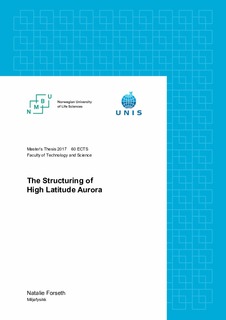| dc.contributor.advisor | Baddeley, Lisa | |
| dc.contributor.advisor | Grimenes, Arne Auen | |
| dc.contributor.advisor | Partamies, Noora | |
| dc.contributor.author | Forseth, Natalie | |
| dc.coverage.spatial | Norway, Svalbard, Longyearbyen | nb_NO |
| dc.date.accessioned | 2017-11-02T13:59:07Z | |
| dc.date.available | 2017-11-02T13:59:07Z | |
| dc.date.issued | 2017 | |
| dc.identifier.uri | http://hdl.handle.net/11250/2463766 | |
| dc.description.abstract | The interaction between the Earths magnetic field and interplanetary magnetic field (IMF), originating from the Sun, is the driving force behind the aurora. Due to the phenomena of polar night, the optical signatures of dayside aurora can be investigated over Svalbard. In order to ease the examination of All-sky camera (ASC) images, an algorithm is used to quantify the observed auroral forms in terms of an “arciness” index (A, ranging from 0 to 1) describing how arc-like the shape of the green emission lines (557.7 nm) in the image is. This algorithm was applied to ASC images from Longyearbyen and Ny-Ålesund between 2000 and 2012, in combination with solar wind parameters (IMF Bz and By components and solar wind velocity) to obtain a general temporal distribution of day- side auroral structures. The temporal distribution as well as the arciness index permits the identification of the type of dayside aurora and their originating precipitation region. The analysis has been done for both polarities of IMF Bz, taking into account the contribution from the IMF By component. Auroral types, earlier defined by Sandholt et al.(2002), were identified by their corresponding arciness: arcs (A=1) or complex structures (A<0.9), their location throughout the day and also their latitudinal location. The effects of the solar wind velocity on the arciness has also been discussed revealing no clear correlation. For weak solar wind velocities (v<400 km/s), a recurring temporal distribution of both arcs (A=1) and complex auroral structures (A<0.9) in the mid-morning sector (09.00-11.00 MLT) was observed and related to cusp auroras and multiple morning arcs. The arciness index permits a simple identification of arc-like auroral forms in the green emission band observed in previous studies. However it does not cover the red emission line (630.0 nm) which is often present in the cusp region. Also, auroral structures not shaped like arcs are challenging to recognize. | nb_NO |
| dc.language.iso | eng | nb_NO |
| dc.publisher | Norwegian University of Life Sciences, Ås | nb_NO |
| dc.rights | Attribution-NonCommercial-NoDerivatives 4.0 Internasjonal | * |
| dc.rights.uri | http://creativecommons.org/licenses/by-nc-nd/4.0/deed.no | * |
| dc.subject | Arciness | nb_NO |
| dc.subject | Svalbard | nb_NO |
| dc.subject | Aurora | nb_NO |
| dc.title | The structuring of high latitude Aurora | nb_NO |
| dc.type | Master thesis | nb_NO |
| dc.description.version | submittedVersion | nb_NO |
| dc.subject.nsi | VDP::Mathematics and natural science: 400 | nb_NO |
| dc.source.pagenumber | 85 | nb_NO |
| dc.description.localcode | M-MR | nb_NO |

